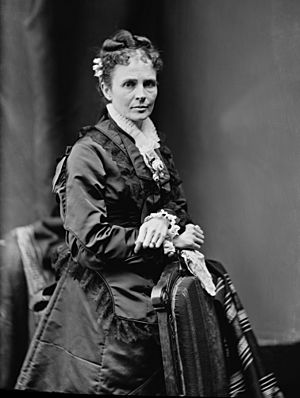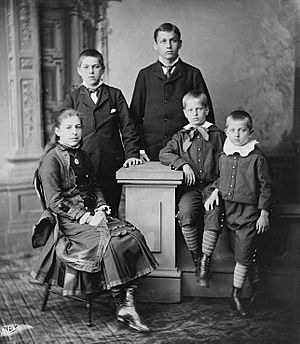Lucretia Garfield facts for kids
Quick facts for kids
Lucretia Garfield
|
|
|---|---|
 |
|
| First Lady of the United States | |
| In role March 4, 1881 – September 19, 1881 |
|
| President | James A. Garfield |
| Preceded by | Lucy Webb Hayes |
| Succeeded by | Mary Arthur McElroy (acting) |
| Personal details | |
| Born |
Lucretia Rudolph
April 19, 1832 Garrettsville, Ohio, U.S. |
| Died | March 13, 1918 (aged 85) South Pasadena, California, U.S. |
| Resting place | James A. Garfield Memorial |
| Spouse | |
| Children | 7, including Hal, James, and Abram |
| Education | Geauga Seminary Hiram College (BA) |
| Signature | |
Lucretia Garfield (born Rudolph; April 19, 1832 – March 13, 1918) was the First Lady of the United States from March to September 1881. She was the wife of James A. Garfield, who was the 20th president of the United States.
Lucretia was born in Garrettsville, Ohio. She first met her future husband, James Garfield, in 1849 at Geauga Seminary. They married in 1858 after a long courtship. They had seven children together, and five of them lived to become adults.
Lucretia Garfield was very educated and loved to learn. She understood how the Republican Party worked. This knowledge greatly helped her husband's political career. She was well-liked during her short time in the White House. However, after only a few months, she became sick with malaria. She went to Long Branch, New Jersey, to get better.
In July 1881, President James Garfield was shot by Charles Guiteau. He was badly hurt and lived for two and a half months before he died. During this time, Lucretia stayed by his side. People across the country felt great sympathy for her. After her husband's death, Lucretia Garfield moved back to her home in Ohio. This home is now known as the James A. Garfield National Historic Site. She spent much of her later life saving her husband's important papers. She created what was like the first presidential library.
Contents
Early Life and Family Background
Lucretia "Crete" Rudolph was born in Garrettsville, Ohio. Her father was Zebulon Rudolph, a farmer. He also helped start the Western Reserve Eclectic Institute, which is now Hiram College. Her mother was Arabella Mason Rudolph.
Lucretia was a devoted member of the Churches of Christ. Her family background included German, Welsh, English, and Irish roots. Her great-grandfather on her father's side came to America from Württemberg, Germany.
Education and Learning
Lucretia attended the Geauga Seminary, where she met James Garfield. After that, she went to the Eclectic Institute. This school believed in educating women, which was not common at the time. Because of this, Lucretia became a very educated woman for her era.
She studied classic subjects like Greek, Latin, French, and German. She also learned about science, biology, math, history, and philosophy. She graduated from Hiram College and then became a teacher.
Romance and Marriage Story
Lucretia first met James Garfield in 1849. She was a student at Hiram College, and James was her teacher. He later went to Williams College. Lucretia stayed behind to teach in Cleveland, Ohio, and Bryan, Ohio.
They started writing letters to each other and soon became engaged. James was impressed by her sharp mind and her desire to learn. Lucretia continued her studies and her teaching. She wanted to be able to support herself if she ever needed to. She did not want to depend on her father for money.
James and Crete were both 26 years old when they married. Their wedding was on November 11, 1858, at her parents' home in Hiram. They were both members of the Churches of Christ. However, a Presbyterian minister named Henry Hitchcock performed the ceremony. The couple did not go on a honeymoon. Instead, they immediately set up their home in Hiram.
James served in the Union Army from 1861 to 1863, which kept them apart. After his first winter in Washington as a new Representative, the family stayed together. They had a home in Washington, D.C., and another home called Lawnfield in Mentor, Ohio. They enjoyed a happy family life.
In Washington, D.C., they shared their love for learning with friends. Lucretia went with James to meetings of a famous literary society. They read books together, visited friends, and traveled together. By 1880, they were almost always together, as much as his career allowed.
The Garfield Children
The Garfields had seven children in total. Two of them, their first and last children, died when they were very young. Eliza Arabella "Trot" Garfield lived from 1860 to 1863. Edward Garfield lived from 1874 to 1876.
Four sons and one daughter grew up to be adults:
- Harry Augustus Garfield (1863–1942) – He became a lawyer, an educator, and a public official.
- James Rudolph Garfield (1865–1950) – He also became a lawyer and a public official.
- Mary "Mollie" Garfield Brown (1867–1947) – She went to private schools. In 1888, she married Joseph Stanley Brown. He was President Garfield's secretary and later an investment banker. She lived in New York and Pasadena, California.
- Irvin McDowell Garfield (1870–1951) – He became a lawyer. He went to Williams College and Columbia Law School. He became a successful lawyer in Boston.
- Abram Garfield (1872–1958) – He became an architect. He graduated from Williams College and the Massachusetts Institute of Technology. He worked as an architect in Cleveland. He also led the Cleveland Planning Commission for many years.
First Lady of the United States
When James Garfield was elected president, his cheerful family moved into the White House in 1881. Lucretia Garfield was not very interested in the social duties of a First Lady. However, she was very dedicated. Her warm welcome made her dinners and twice-weekly receptions enjoyable for guests.
Besides hosting events, Lucretia gave advice to her husband. She helped him choose people for his cabinet. Her choice for Secretary of State, James G. Blaine, turned out to be a good one. Her diaries show that she understood how each choice would affect different groups within the Republican Party. She carefully thought about these effects.
Her early education made her interested in history. She started making plans to turn the historic White House into a cultural center for Washington, D.C. Lucretia went to the Library of Congress to research the White House's history. She wanted to bring a "sense of history" to the building. She felt as if the White House had seen so much history in its eighty years.
Sadly, she became sick with malaria. By the time she got better, President Garfield had been shot. She was still recovering at Elberon, a seaside resort in New Jersey. Her husband was shot by Charles Guiteau on July 2 at a railway station in Washington. The President was actually planning to take a train to New Jersey that day to meet his wife.
The First Lady quickly returned to Washington by a special train. An eyewitness said she was "frail, fatigued, desperate, but firm and quiet and full of purpose to save." Her train went so fast that its engine broke near Bowie, Maryland. Lucretia Garfield was thrown from her seat but was not hurt. After a worrying delay, she reached the White House and went straight to her husband's bedside.
One of the doctors caring for President Garfield was a woman, Dr. Susan Edson. However, she was paid only half of what the male doctors received. When Lucretia heard about this unfair pay, she wrote a letter showing her anger. She used the word "discrimination" to describe her fury. After her letter, Dr. Edson received the same pay as the men.
For three months, the President fought for his life. During this time, Lucretia's sadness and dedication earned the respect and sympathy of the whole country. After his death and funeral, the grieving family went home to their farm in northern Ohio. For the next 36 years, she lived a private but busy and comfortable life. She worked hard to preserve the records of her husband's career. She added a wing to their home that became a library for his papers.
Later Life and Legacy
Lucretia lived comfortably thanks to a $350,000 trust fund. This fund was set up for her and the Garfield children by a financier named Cyrus W. Field. She spent her winters in South Pasadena, California. There, she built a home that she helped design with famous architects Greene and Greene.
Although she never openly supported women's right to vote, her daughter said that her mother believed in equal rights for women. Lucretia also attended events held by Theodore Roosevelt to support him.
When the United States entered World War I, Lucretia became a volunteer for the Red Cross. She passed away at her home in South Pasadena on March 14, 1918, at the age of 85. Her coffin was placed next to her husband's in the crypt of the James A. Garfield Memorial. This memorial is located at Lake View Cemetery in Cleveland, Ohio.
Images for kids
See also
 In Spanish: Lucretia Garfield para niños
In Spanish: Lucretia Garfield para niños




